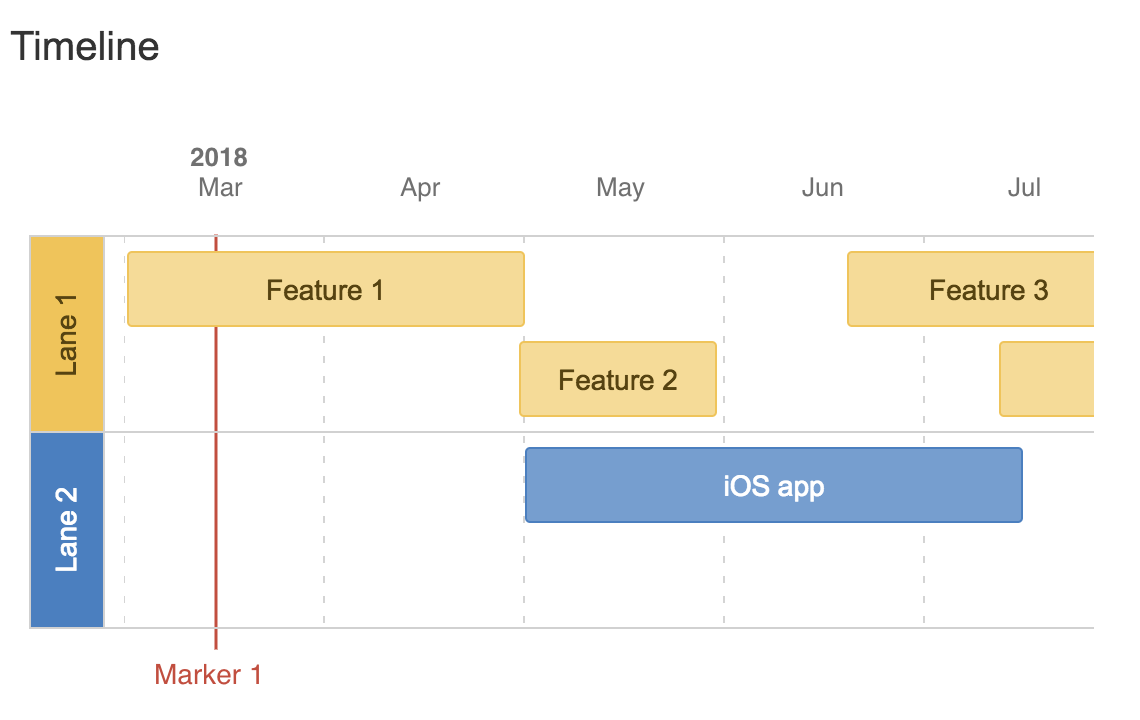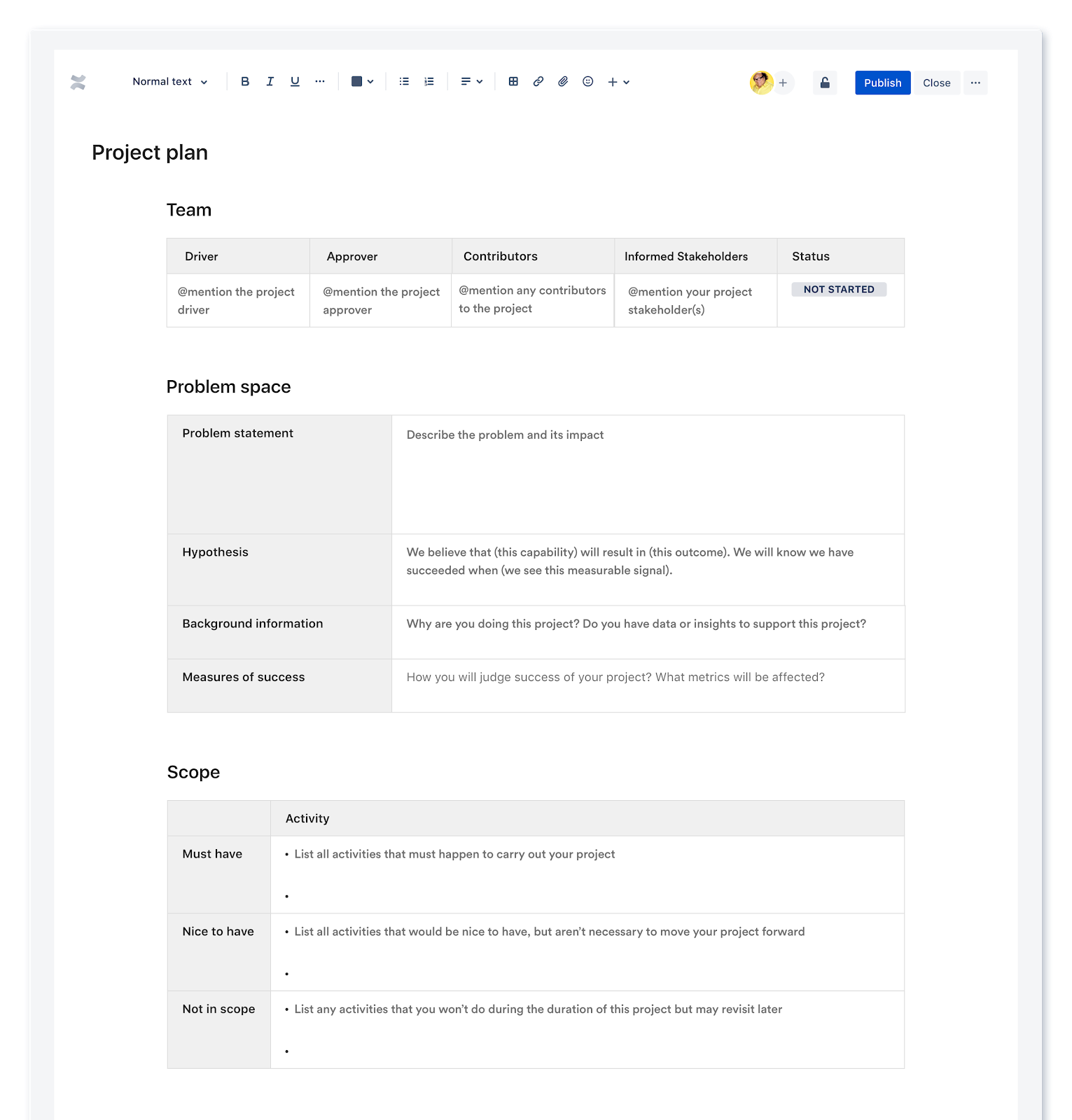Jak tworzyć proste, skuteczne plany projektów
Dobry plan projektu to coś więcej niż lista zadań do wykonania i terminów
Przeglądaj tematy
Słysząc o „planie projektu”, większość z nas wyobraża sobie jakiś harmonogram — listę punktów określających, co i kiedy trzeba zrobić. W rzeczywistości to tylko drobna część planu. Dobry kierownik projektu opracowuje plan, który obejmuje nie tylko problem do rozwiązania, ale także jego zakres, rezultaty, ryzyko i zależności — wyznaczając w ten sposób ścieżkę do sukcesu projektu.
Bez planu projektu członkowie zespołu mogą się pogubić się w labiryncie złożoności. Mogą nie wiedzieć, od czego zacząć, albo — co gorsza — zabrać się do roboty bez świadomości, w jaki sposób ich praca wpisuje się w szerszy obraz.
Czym jest planowanie projektu?
Planowanie projektu to proces określania celów, zakresu i działań wymaganych do ukończenia projektu. Jest to podstawowy aspekt zarządzania projektem, obejmujący ustalenie jasnych celów, identyfikację zasobów, oszacowanie kosztów i opracowanie planu działań umożliwiającego skuteczną realizację.
Planowanie projektu stanowi podstawę skutecznego wykonania, monitorowania i nadzoru. Proces ten umożliwia menedżerom projektów i zespołom wzajemne dostosowanie wysiłków i zasobów, ogranicza zakres niepewności i zwiększa szanse na realizację projektu na czas i zgodnie z budżetem.
Czym jest plan projektu?
Plan projektu jest wymiernym wynikiem procesu planowania projektu. Jest to wszechstronny dokument, który przedstawia kluczowe elementy projektu, w tym jego cele, zakres, harmonogram, wymagania dotyczące zasobów, ryzyko i istniejące zależności.
Plan projektu pełni rolę wytycznych dla wszystkich interesariuszy i zapewnia jasne zrozumienie celu projektu, kamieni milowych oraz oczekiwanych rezultatów. Wskazuje członków zespołu, określa narzędzia niezbędne do rozplanowania projektu i szczegółowo opisuje niezbędne kroki.
Dobrze skonstruowany plan projektu nie tylko ukierunkowuje realizację projektu, ale także służy jako narzędzie komunikacji, dzięki któremu wszyscy uczestnicy są doinformowani i zgrani przez cały cykl życia projektu.
Korzyści z planowania projektu
- Przejrzystość i dopasowanie: rozplanowanie projektu zapewnia właściwe zrozumienie celów i zakresu projektu, wspólne dla wszystkich członków zespołu i interesariuszy. Taka przejrzystość pozwala ograniczyć nieporozumienia i konflikty oczekiwań.
- Przydzielanie zasobów: pomaga w określaniu i przydzielaniu wymaganych zasobów: ludzkich, finansowych i materialnych. To pozwala zoptymalizować ich wykorzystanie i zapobiegać marnotrawstwu.
- Zarządzanie ryzykiem: planowanie projektu umożliwia identyfikację i ocenę potencjalnych zagrożeń. Przewidzenie z góry źródeł ryzyka pozwala zespołowi proaktywnie się do nich odnieść i je ograniczyć.
- Zarządzanie czasem: dobrze skonstruowany plan projektu obejmuje oś czasu z kamieniami milowymi i zależnościami między poszczególnymi zadaniami, co ułatwia zarządzanie harmonogramami projektów i dotrzymywanie terminów.
- Kontrola kosztów: oszacowanie kosztów projektu na etapie planowania pozwala organizacji skuteczniej kontrolować wydatki.
- Lepsza komunikacja: plan projektu pełni rolę narzędzia komunikacji dostarczającego informacji wszystkim interesariuszom, a tym samym zapewnia, że wszyscy są świadomi postępów projektu, zmian i ewentualnych problemów.
- Zapewnienie jakości: proces planowania może obejmować standardy jakości i procesy gwarantujące wysoką jakość rezultatów.
- Zwiększona odpowiedzialność: plan projektu jasno określa osoby odpowiedzialne za poszczególne zadania, promując poczucie obowiązku.
- Efektywne podejmowanie decyzji: planowanie pomaga zdefiniować procesy decyzyjne, co ułatwia rozwiązywanie problemów i podejmowanie krytycznych wyborów w miarę postępów projektu.
Proces planowania projektu (kroki)
Zastosowanie podejścia krok po kroku do tworzenia planu projektu może wydawać się przerostem formy nad treścią, niemniej jednak ma kluczowe znaczenie dla budowania solidnej i skutecznej strategii. Przed rozpoczęciem procesu planowania warto poświęcić trochę czasu na zastanowienie się nad swoim zespołem, organizacją, dostępnymi zasobami i celami projektu. Ważne jest, aby od samego początku procesu planowania zadbać o jednakowe zrozumienie założeń projektu w obrębie całego zespołu.
Krok 1: Potraktuj plan projektu jak mapę
Kiedy wytyczasz trasę na mapie, zapewne zadajesz sobie następujące pytania:
- Jaki jest cel podróży?
- Skąd będę wiedzieć, że jestem na miejscu?
- Kto jeszcze będzie korzystać z tej mapy?
- Jakie kamienie milowe będą mijać po drodze?
- Jakie przeszkody mogą napotkać?
Czy są dostępne alternatywne trasy?
Krok 2: Poznaj uczestników projektu
Rozeznaj się w kwestii relacji wewnątrzfirmowych, trudnych osobowości i możliwych punktów zapalnych, które mogą mieć wpływ na proces zarządzania projektem. Larry W. Smith, profesjonalista w zakresie zarządzania projektami, menedżer projektu w Software Technology Support Center, podkreśla znaczenie analizy interesariuszy. Jego zdaniem wszyscy uczestnicy chcą, aby projekt się powiódł, ale wystarczy zapomnieć o potrzebach jednego wpływowego interesariusza, aby wszystko legło w gruzach.
Smith radzi, aby poświęcić czas na:
- Ustalenie, kim są osoby zainteresowane w danym projekcie
- Poznanie ich oczekiwań i stopnia wpływu
- Określenie sposobu, w jaki uwzględniane będę informacje zwrotne od współpracowników i osób zainteresowanych w miarę postępu projektu
- Uwzględnienie wszystkich potrzeb i oczekiwań podczas planowania strategii zarządzania ryzykiem i reagowania na zagrożenia
- Dokładne zaplanowanie wszystkich strategii komunikacji w ramach projektu
Przejrzysta komunikacja jest nie do przecenienia. Dlatego Bernie Ferguson, ekspert ds. zarządzania projektami w Atlassian, zaczyna komunikować się z interesariuszami już od samego początku projektu:
„Używamy techniki plakatu projektu, aby budować wspólne zrozumienie między członkami zespołu i interesariuszami. Co robimy? Jaka jest tego wartość dla klientów i dla firmy? Dlaczego uważamy, że jest to właściwe rozwiązanie? Otrzymujemy informacje zwrotne w odpowiedziach na te wszystkie pytania, zanim cokolwiek trafi do planu działań”. — Bernie Ferguson, Atlassian
Krok 3: Zaplanuj harmonogramu bez złudzeń
Menedżerowie projektów często popełniają błąd wykazywania nadmiernego optymizmu. Zamiast skupiać się na osiągnięciu najlepszego możliwego wyniku, powinni rozważyć mogące się pojawić problemy oraz ich ewentualny wpływ na harmonogram zarządzania projektem.
Przeprowadzenie niezbędnej analizy należytej staranności, ćwiczeń pre-mortem lub indywidualnych spotkań z kluczowymi interesariuszami to świetny sposób na zidentyfikowanie potencjalnych przeszkód.
Rozważ naszkicowanie osi czasu poprzez zapytanie innych menedżerów projektów, ile czasu zajmuje im zazwyczaj planowanie podobnych przedsięwzięć. Zorganizuj spotkanie z zespołem, z którym będziesz współpracować, aby się dowiedzieć, ile czasu potrwa wykonanie poszczególnych zadań. Użyj narzędzi do zarządzania projektem i odszukaj w archiwum przykłady wcześniejszych realizacji.

Konsekwentnie podkreślaj znaczenie komunikacji. Informuj wszystkie zainteresowane strony o szczegółach projektu — nikt nie lubi błądzić po omacku. Uproszczone wykresy Gantta stanowią skuteczny i łatwo zrozumiały dla każdego sposób wizualizacji harmonogramu.
Krok 4: Rekrutuj przyjaciół i współpracowników
Do Ciebie jako menedżera projektu należy dostarczenie planu projektu (i ostatecznie samego projektu). Nie polega to jednak na jednorazowym przelaniu wszystkich informacji na papier. Podczas opracowywania planu projektu musisz zaangażować wszystkich kluczowych interesariuszy. Bądźcie w stałym kontakcie. Dzięki temu przekonasz się, że są cennymi zasobami.
Dzięki zebraniu przemyśleń od zespołu i wspólnej burzy mózgów możesz szybko dojść do ważnych wniosków. Współpraca w zespole sprzyja poczuciu wzajemnego wsparcia, a tym samym umożliwia tworzenie lepszych planów.
W firmie Atlassian korzystamy z szablonów, aby zmniejszyć koszty ogólne związane z procesem planowania i zainicjować dyskusje niezbędne do stosowania najlepszych praktyk. Szablony planu projektu to doskonały sposób na zachęcenie uczestników do zastanowienia się nad aspektami zarządzania projektem, których wcześniej nie brali pod uwagę.
Przygotowanie ciekawej prezentacji projektu to jedno, ale stworzenie solidnego i skutecznego planu to zupełnie co innego. Umówmy się: mapowanie ryzyka i zależności w projekcie nie jest przyjemne. Zaawansowane szablony Atlassian i pomocne podpowiedzi umożliwiają menedżerom projektów metodyczne myślenie w zakresie tworzenia planów projektów, co przekłada się na mniejszą liczbę niedopatrzeń i większą produktywność.

Krok 5: Przemyśl cele i zakres projektu
Zdefiniuj problem, aby jasno określić, co konkretnie próbujesz osiągnąć. Następnie sformułuj hipotezę wskazującą, co Twoim zdaniem powinno się wydarzyć w wyniku rozwiązania danego problemu. Opisz pokrótce kontekst projektu z uwzględnieniem danych lub spostrzeżeń potwierdzających. Na koniec ustal kluczowe wskaźniki, których użyjesz do oceny sukcesu projektu. Wskaźniki te prawdopodobnie wpłyną na różne aspekty Twojego planu, kształtując jego kierunek i cel.
Zapytaj członków zespołu o to, czego faktycznie potrzebują — nie o to, co miło by było mieć lub co jest wręcz zbędne. Jasne określenie zakresu projektu na wczesnym etapie procesu planowania, z uwzględnieniem elementów wyraźnie wykluczonych, minimalizuje ryzyko nieporozumień w kontaktach z interesariuszami. Ułatwia również przydzielenie odpowiedniego czasu dla poszczególnych współautorów projektu. Przejrzystość ułatwia identyfikację zmian w zakresie projektu i zarządzanie nimi w miarę ich pojawiania się.
Krok 6: Przewiduj niespodzianki
Niemal wszystkie plany projektów zawierają informacje na temat budżetu, harmonogramów i zakresu projektu. Plan doskonały odpowiada również na istotne pytania dotyczące projektu, w tym:
- Zasoby: jakich umiejętności wymaga projekt? Kto jest dostępny? Jakim budżetem dysponujemy?
- Decyzje: kto będzie wydawał rekomendacje? Kto zatwierdza lub odrzuca wnioski?
- Komunikacja: kto będzie odpowiedzialny za informowanie o postępach i przeszkodach w projekcie?
- Ryzyko: na co powinni uważać członkowie zespołu? Jak wygląda proces dokumentowania i śledzenia zagrożeń?
- Kontrola: jak zamierzasz zgromadzić informacje zwrotne przed dostarczeniem projektu?
- Zatwierdzenia: kto jeszcze musi zatwierdzić końcowy rezultat projektu? Kto jest ostatecznym decydentem?
Czas: czy Twoje codzienne obowiązki nie kolidują z harmonogramem projektu? W jaki sposób został wybrany termin?
Plan nie musi szczegółowo opisywać każdej z tych kwestii, ale powinien zawierać wystarczającą ilość informacji, aby umożliwić płynną realizację bez istotnych niespodzianek.
Znacznik wyboru Wskazówka: użyj metody DACI do podejmowania trafnych i terminowych decyzji dotyczących projektu.
Wskazówka: użyj metody DACI do podejmowania trafnych i terminowych decyzji dotyczących projektu.
Krok 7: Wybierz podejście do zarządzania projektami
Większość menedżerów projektów wybiera model kaskadowy lub Agile do zarządzania projektami. Podejście Agile zapewnia szybkie rezultaty dzięki iteracyjnemu procesowi, w którym stale są oceniane plany, wymagania i wyniki projektu. W tej metodzie czas i zasoby uznaje się za stałe.
Model kaskadowy to liniowy, sekwencyjny proces, w ramach którego projekt stopniowo przechodzi przez kolejne etapy i kolejne zespoły. W tym podejściu to zakres jest stały, natomiast harmonogram i zasoby są elastyczne.
Krok 8: Napisz i oceń swój plan
Po udzieleniu odpowiedzi na wszystkie pytania, przeprowadzeniu dyskusji i zapisaniu całej góry samoprzylepnych karteczek nadchodzi wreszcie czas, aby napisać plan projektu. Należy przy tym zachować prostotę, zarówno pod względem słownictwa, jak i formatowania.
Oto kilka elementów, które powinny być częścią każdego planu:
- Nazwa projektu
- Termin realizacji
- Budżet
- Cele planu
- Najważniejsze kamienie milowe i oczekiwany wymierny skutek
- Oczekiwany termin rozpoczęcia i ukończenia każdego zadania
- Wskazanie właścicieli poszczególnych zadań
- Szczegóły zadań i uwagi wyjaśniające ich wynik
Opis ryzyk oraz zadań (lub zespołów), które są od siebie zależne, aby uniknąć opóźnień
Po zakończeniu tworzenia planu projektu poświęć chwilę, aby poprosić kogoś, kto jeszcze nie był zaangażowany w ten proces, o jego sprawdzenie. Dodatkowa para oczu może pomóc w znalezieniu oczywistych błędów.
Znacznik wyboru Porada: szacując rozmiar każdego zadania, oprzyj się pokusie wnikania w szczegóły. Pamiętaj, że to orientacyjne dane.
Porada: szacując rozmiar każdego zadania, oprzyj się pokusie wnikania w szczegóły. Pamiętaj, że to orientacyjne dane.
Krok 9: Udostępnij swój plan całemu światu!
Gdy plan projektu zostanie ukończony i dokładnie sprawdzony, czas, aby udostępnić go osobom aktywnie zaangażowanym i interesariuszom, którzy muszą być informowani na bieżąco. Przygotuj się na ekscytujące rozpoczęcie projektu, które sprawi, że wszystko ruszy z miejsca. Ważne jest, aby mieć świadomość, że zmiany i wyzwania są integralną częścią każdego projektu, dlatego przygotowanie się do zarządzania nimi jest kluczowe.
Przez cały cykl życia projektu ściśle trzymaj się swojego planu. Skoncentruj się na podstawowych elementach projektu, zamierzonym zakresie i uzgodnionych krokach. Takie podejście gwarantuje, że pozostaniesz na właściwym kursie i zwiększysz prawdopodobieństwo udanej realizacji projektu, nawet w obliczu nieoczekiwanych wydarzeń.
Przykład planu projektu
Oto uproszczony przykład planu projektu kampanii marketingowej:
Nazwa projektu: Wiosenna kampania wprowadzenia produktu na rynek
- Cele ogólne i szczegółowe projektu:
- Zwiększenie widoczności marki o 20%.
- Pozyskanie 1000 potencjalnych klientów w ciągu trzech miesięcy.
- Zwiększenie przychodów ze sprzedaży o 15% w sezonie wiosennym.
- Zakres:
- Utworzenie serii materiałów marketingowych online i offline.
- Uruchomienie nowej linii produktów.
- Przeprowadzenie cyfrowych kampanii reklamowych.
- Harmonogram projektu:
- Faza 1 (1–2 miesiąc): strategia kampanii i tworzenie treści.
- Faza 2 (3 miesiąc): wprowadzenie na rynek i realizacja działań marketingowych.
- Zasoby:
- Zespół marketingowy (4 członków).
- 50 000 USD budżetu na reklamę i materiały.
- Zagrożenia:
- Nieprzewidywalna pogoda wpływająca na wydarzenia plenerowe.
- Konkurencja rynkowa prowadzi do wojen cenowych.
- Zależności:
- Zakończenie rozwoju produktu (przed uruchomieniem kampanii).
- Dostępność materiałów marketingowych (przed rozpoczęciem działań reklamowych).
- Zapewnianie jakości:
- Regularne recenzje i sesje przekazywania informacji zwrotnych w celu zapewnienia wysokiej jakości treści.
- Właściciele zadań:
- Strategia kampanii: Sabina
- Tworzenie treści: Jan
- Wprowadzenie produktu na rynek: Emilia
Kampanie reklamowe: Marek
Ten przykładowy plan obejmuje cele projektu, zakres, harmonogram, zasoby, zagrożenia, zależności i procedury kontroli jakości, co czyni go cennym punktem odniesienia dla interesariuszy i członków zespołu projektowego w trakcie całej kampanii.
Tworzenie skutecznych planów projektów
W przypadku zarządzania projektami kompleksowy i dobrze skonstruowany plan projektu jest kompasem, który wskazuje zespołom i interesariuszom drogę do pomyślnego ukończenia projektu. Planowanie projektu to nie tylko lista kontrolna zadań, ale skomplikowany proces, który obejmuje definiowanie celów projektu, przydzielanie zasobów, ocenę zagrożeń i plan działania prowadzący do sukcesu.
Dzięki przemyślanemu, etapowemu podejściu menedżerowie projektów mogą wzmacniać przejrzystość, współpracę i zdolność adaptacji w całym cyklu życia projektu, ostatecznie zwiększając szanse na realizację projektów na czas i w ramach budżetu.
